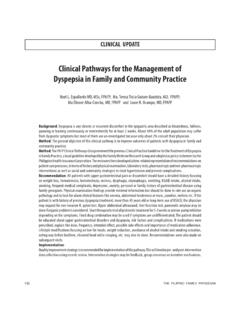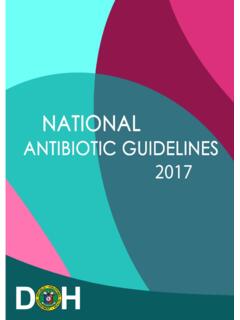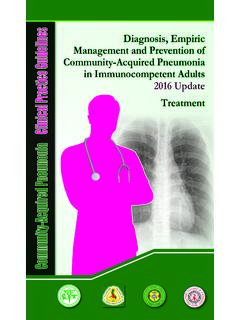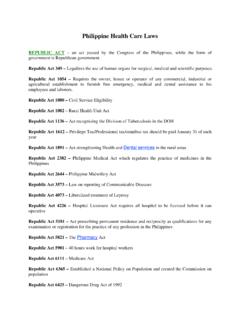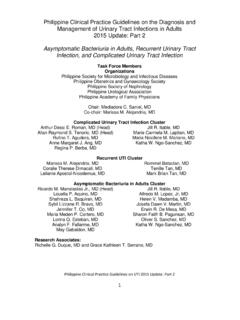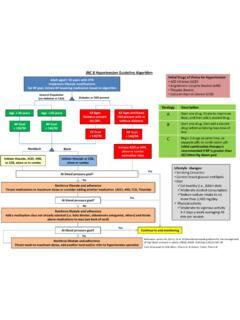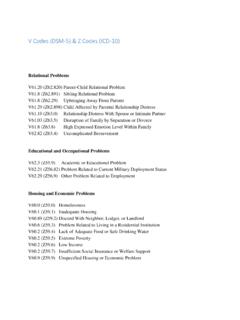Transcription of Clinical Practice Guidelines on the Diagnosis and ...
1 Clinical Practice Guidelines on the Diagnosis and Treatment of Gastroesophageal Reflux Disease (GERD)Jose D. Sollano, ; Rommel P. Romano, ; Leticia Iba ez-Guzman, ; Marie Antoinette DC Lontok, ; Sherrie Q. de Ocampo, ; Allan A. Policarpio, ; Roberto N. de Guzman Jr., 4; Carmelita D. Dalupang, ; Augusto Jose G. Galang, ; Ernesto G. Olympia, ; Maria Anna L. Chua, ; Bernadette A. Moscoso, ; Jose A. Tan, ; John Arnel N. Pangilinan, ; Arnold O. Vitug, ; Marichona C. Naval, ; Danilo A. Encarnacion, ; Peter P. Sy, ; Evan G. Ong, ; Oscar T. Cabahug, ; Maria Lourdes O. Daez, ; Albert E. Ismael, ; Joseph C. Bocobo, 53 Number 3 July-September, 2015 1 1 University of Santo Tomas, Manila 2 University of the Philippines, Manila 3St. Luke s School of Medicine, Quezon City 4 Metropolitan Hospital, Tondo, Manila 5 Angeles University Foundation, Angeles City 6 Makati Medical Center, Makati City 7 Riverside Medical Center, Bacolod City 8 Cebu Doctors University, Cebu City 9 Chinese General Hospital and Medical Center, Manila 10 Veterans Memorial Medical Center, Quezon City 11 East Avenue Medical Center, Quezon City 12St.
2 Paul s Hospital Iloilo, Iloilo City 13 Cardinal Santos Medical Center, Manila 14 University of the East, Sampaloc, ManilaCorresponding Author: Jose D. Sollano, , Univeristy of Santo Tomas Hospital, Espana Blvd, Manila, PhilippinesEmail: In the last two decades gastroesophageal reflux disease (GERD), initially thought to be a disease only common in the West, is described increasingly in Asia, including the Philippines. A recent local report indicated that the prevalence of erosive esophagitis (EE), a common complication of GERD, has more than doubled, , to , between the two time periods of 1994 1997 and 2000 2003, respectively. GERD causes recurrent annoying symptoms which are common reasons for clinic visits and consultations thus, it is the objective of these Guidelines to provide both primary care physicians (PCPs) and specialists a current, evidence-based, country-specific recommendations for the optimal management of GERD.
3 These Guidelines are intended to empower PCPs to make a clinic-based Diagnosis to between two time periods, 1994 1997 and 2000 2003, On the other hand, it is estimated that 11 12% of the general population have non-erosive reflux disease (NERD) and a considerably higher proportion of symptomatic patients presenting for endoscopy may suffer from NERD, , 37-87%.14 The bothersome symptoms of GERD and its associated morbidities result in loss of productivity and a diminished quality of ,16 In addition, concerns that long-term symptomatic GERD may be a risk factor for adenocarcinoma of the distal esophagus has put the disease high in the consciousness of and a source of anxiety for both physicians and These are common reasons for clinic visits and consultations thus, it is our objective to provide the primary care physicians (PCPs), as well as, the specialists an updated, evidence-based, country-specific set of recommendations for the current management of GERD.
4 Methods: In order to assess the needs of local medical practitioners regarding the proper Diagnosis and treatment of GERD a core working party composed of ten (10) members (JDS, LIG, MADL, SQdO, AAP, RNG, CDD, RPR, AJGG and JCB) was convened in June 24, 2013. The members were chosen for their expertise in medical epidemiology, evidence-based medicine, academic affiliations, active Clinical Practice and research in gastroenterology. Several meetings and consultations were done in order to gather ForewordClinical Practice GuidelinesPhilippine Journal of Internal Medicineof GERD, to start an empiric acid-suppressive therapy in the appropriate patient, and direct them to select which GERD patient may need to undergo investigations to ascertain further the Diagnosis of GERD or to assess outcomes of therapy.
5 We acknowledge that studies published in the future may influence the impact on our confidence on the recommendations enumerated in these Guidelines thus, we commit to update this document when it is deemed : Gastroesophageal reflux disease, erosive esophagitis, non-erosive reflux disease, refractory GERD, extraesophageal GERD, Barrett s esophagus, proton pump inhibitor, upper endoscopy , heartburn, acid regurgitation, alarm featuresIntroductionBackground: Gastroesophageal reflux disease (GERD) is an increasingly common disorder that gastroenterologists and general physicians encounter in daily Practice . In Eastern Asia, the prevalence of GERD has risen from before 2005 to from 2005 to The prevalence rate of erosive reflux disease (ERD) reported from our region is between , figures which are almost similar to those reported in the In Asia, time trend studies during the last two decades reveal that the prevalence of erosive esophagitis (EE) has increased from in 1995 to in In the Philippines, the prevalence of EE increased from specific GERD management concerns of PCPs and gastroenterologists.
6 A review of scientific papers from different accredited training institutions of the Philippine Society of Gastroenterology (PSG) was performed. In addition, an electronic data collection form was circulated to 15 training institutions all over the country to generate current information on demographics, etiology, management and outcomes of consecutive GERD patients seen in their units over a 30-day period in early 2014. A pre-consensus development workshop was held where the results of the surveys and several reviews were presented and discussed. Important issues were identified and forwarded to the core working party for further deliberations. A list of 27 issues, ranging from definition of terminologies related to reflux disease, diagnostic work-up, roles of H.
7 Pylori (Hp), diet and surgery, first-line and adjuvant treatments for GERD and management of treatment failures and complications were collated and appropriate recommendations were formulated for each issue. Recommendations were based from extensive literature searches of Medline, Embase, the Cochrane Central Register of Controlled Trials and ISI Web of Knowledge, including manual searches in bibliographies of key articles, proceedings of abstracts of major gastroenterology and endoscopy meetings held in the past five years ( asian pacific digestive Week (APDW), digestive Disease Week (DDW) and United European Gastroenterology Week (UEGW) and articles published in the Philippine Journal of Internal Medicine and Philippine Journal of Gastroenterology.)
8 Following the modified Delphi process, the 27 recommendations proposed by the core working party were circulated to all training program directors, chiefs of section, and PSG committee chairs for electronic voting by email. Voting for every statement was done as follows; (1) Accept completely; (2) Accept with some reservation; (3) Accept with major reservation; (4) Reject with reservation; (5) Reject completely. Additional comments were encouraged for each statement and revisions made accordingly during subsequent deliberations of the core working party. After the electronic voting, a consensus development conference was held in February 2014 participated in by the training program directors and the core working party. Each participant was assigned to present and defend a statement/recommendation.
9 During the conference, the presenters were required to evaluate appropriate publications, taking special care to include publications from the Philippines and where there are none, papers from Asia were preferred. Robust discussion and debate were encouraged during the consensus development conference and subsequent voting on every statement was conducted anonymously using a wireless keypad system. If the pre-determined agreement of 85% was not achieved, the statement is rejected. The level of evidence and the strength for 2 Volume 53 Number 3 July-September, 2015each recommendation were rated by the participants using the Grading of Recommendations Assessment, Development, and Evaluation (GRADE) process, as follows; a) High Further research is very unlikely to change our confidence in the estimate of effect b) Moderate further research is likely to have an important impact on our confidence in the estimate of effect and may change the estimate c) Low further research is very likely to have an important impact on our confidence in the estimate of effect and is likely to change the estimate d) Very low any estimate of effect is uncertain.
10 The strength of recommendation was classified as follows; a) strong b) conditional. The participants were constantly reminded that care is needed so as to recognize that quality of evidence is not necessarily synonymous with strength of recommendation , and vice versa; and that their informed judgment is necessary. An unrestricted educational grant from Takeda Pharmaceutical, Inc. made possible the preparation and completion of this document. During the entire duration of the consensus process, as well as, in the writing of the manuscript, no interference or representations by any third party were allowed by the consensus development group. Practice GUIDELINE RECOMMENDATIONS:Recommendation #1: GERD is a condition resulting from the recurrent backflow of gastric contents into the esophagus and adjacent structures causing troublesome symptoms and/or tissue injury.
